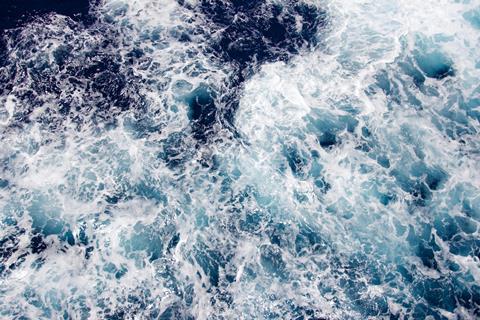A new method vastly improves on the existing approach for single-cell genetic sequencing, enabling scientists to read the genomes of individual cells and viral particles in the environment more quickly, efficiently, and cost-effectively.

In a new study in Nature Microbiology, researchers from Bigelow Laboratory for Ocean Sciences and Atrandi Biosciences provide the first environmental application of the approach, which they call environmental microcompartment genomics. Sequencing the microbiome in a sample of surface seawater from the Gulf of Maine, the researchers showcased the method’s advantages compared to traditional processes, particularly for studying the diverse and complex world of marine viruses.
READ MORE: New technique reveals marine microbes’ outsized role in carbon cycle
READ MORE: Fats provide clues to life at its limits in the deep sea
“This work demonstrates how we can increase the throughput of single particle genomics, increasing not just the quantity but also the quality of the data,” said Alaina Weinheimer, a postdoctoral fellow and the paper’s lead author. “You can study your whole microbe community in this comprehensive manner that has not been possible — at reduced cost without sacrificing quality.”
Order of magnitude
The traditional method, revolutionized by Bigelow Laboratory’s Single Cell Genomics Center, involves sorting all the individual particles in a sample into their own well on a microplate. That enables scientists to process 384 particles in one run. The new approach increases that throughput by an order of magnitude. In the study, the researchers obtained genomic sequences from over 2,000 particles in just 300 nanoliters, or less than a millionth of a liter, of seawater.
Microcompartment genomics relies on recent advances in microfluidic technology. A sample is compartmentalized into thousands of tiny, semipermeable bubbles, each containing a trillionth of a liter of water. Single cells or particles are randomly sampled into individual compartments, and reagents are used to make lots of copies of the DNA. That amplified DNA is then tagged with a unique barcode. When the bubbles are dissolved, and all the material is combined to be sequenced, that barcode is used to stitch together corresponding sequences into a complete genome.
Sediment and soil
Though this first application uses seawater, Weinheimer said that early testing shows that the process also works on sediment and soil samples, which can be hard to study with methods that struggle to differentiate cells from non-biological particles.
The approach does not use flow cytometry, like the standard single-cell sequencing method. That means that scientists lose some of the descriptive data that flow cytometry provides, but the advantage is that there’s no size-based pre-sorting required, so any particle of any size can be sequenced.
“This approach omits any size selection, so we can process everything from large microbes to the tiniest of viruses, or even free-floating DNA, simultaneously,” Weinheimer said. “You’re looking at the microbial community in a very holistic way.”
World of mysteries
“Nature’s microbial world remains full of mysteries, due to its extreme biodiversity and the small physical scales that makes it hard to study,” added Ramunas Stepanauskas, director of SCGC and senior author on the new study. “Environmental microcompartment genomics creates completely new opportunities for the study of that world.”
This rapid, size-agnostic approach will be particularly valuable for studying viruses, which make up the vast majority of the microbes in the ocean but come in a wide range of sizes and can often be too small to isolate with a flow cytometer.
Indeed, the study highlights some of the advantages of the new approach compared to existing single-cell and metagenomic methods.
Though all of the methods the authors tested agreed in terms of the broad composition of the microbial community — providing assurances that the new method works — the microcompartment approach generated some unique insights. For example, the methods that use flow cytometry appeared to pick up more large viruses, whereas the new approach captured viruses of all sizes present in the sample. Likewise, the microcompartment approach provided genome sequences that were more complete and of higher quality than the widely used metagenomic methods.
Overlooked viral genomes
The scientists also found that many of the viral genomes identified using the new approach belonged to a family of viruses called Naomiviridae that have only been recently cultured and have such an unusual DNA structure they can be excluded using other methods.
“This group of viruses was the most abundant in our dataset, and we found evidence that it may infect the most abundant bacteria in the ocean, but we would have missed it entirely with other methods,” Weinheimer said. “We’re showing that there’s a lot that can still be discovered about the viral community that’s currently invisible to us that we’re starting to unlock with these new methods.”
The work was funded by the National Science Foundation, Simons Foundation, and the Research Council of Lithuania. Co-authors include scientists at Vilnius University and Atrandi Biosciences in Lithuania, as well as several Bigelow Laboratory researchers, including Brian Thompson, Julia Brown, Jacob Munson-McGee, Greg Gavelis, Corianna Mascena, and Nicole Poulton.
Topics
- Alaina Weinheimer
- Atrandi Biosciences
- Bigelow Laboratory for Ocean Sciences
- Early Career Research
- Environmental Microbiology
- Healthy Land
- Innovation News
- Microbiological Methods
- Ocean Sustainability
- Ramunas Stepanauskas
- seawater
- sediment
- USA & Canada
- Vilnius University
- Viruses
- Whole genome sequencing
- Young Innovators







No comments yet